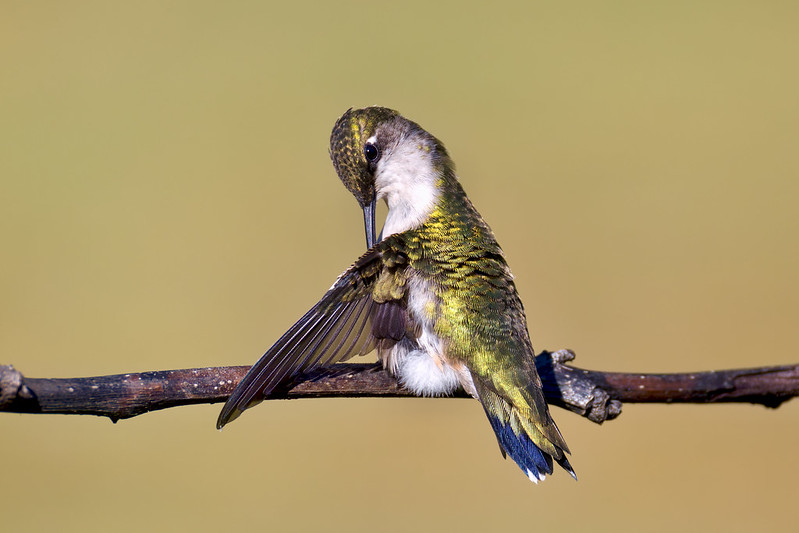The feeders in my yard are still hanging, their red and yellow plastic glowing in the fall sunlight, but they’ve been quiet for two days now. The last Ruby-throated Hummingbird I saw was on October 10, and unless a late traveler shows up, that may have been the end of the season here in Arkansas.

I’ll keep the feeders out a bit longer, just in case. Sometimes a straggler comes through, tired and hungry after a long flight. Leaving them up costs nothing, and it might help a bird make it across the Gulf.
Ruby-throated Hummingbird Migration Notes
Ruby-throated Hummingbirds usually leave Arkansas between late September and mid-October. Males go first, sometimes by late August. Females and young birds follow through September and early October. By mid-month, most have headed south toward Mexico and Central America.
Their migration isn’t triggered by temperature, it’s about light. As days shorten, hormones shift, telling them it’s time to move. Before leaving, they double their weight with fat reserves that fuel the trip. Some make a 500-mile flight across the Gulf of Mexico in one go, flying for nearly a full day without stopping.
The bird in this photo was preening, running its bill through each feather to keep them aligned and in good shape. Good feather condition is critical for migration. Any damage reduces flight efficiency, and that can mean the difference between survival and exhaustion.
Late migrants do happen. Juveniles, especially, may linger into late October or early November if food remains and the weather holds. That’s why many birders keep feeders up well past the date of their last sighting. The old myth that feeders stop migration isn’t true. Hummingbirds move based on instinct and daylight, not food supply.
I’ll miss them. Their buzzing, their fights over territory, the flashes of green and red outside my window. But they’ll return. By late April or early May, the males will arrive first, ready to claim their spots. I’ll have fresh nectar waiting.
Hummingbird Photography Notes and Tips
I photographed this Ruby-throated Hummingbird while it was preening in soft afternoon light. I used the Canon EOS R5 Mark II and the RF 200–800mm f/6.3–9 IS USM at full zoom. Shooting from about 15 feet away gave me close framing without making the bird nervous.
- Camera: Canon EOS R5 Mark II
- Lens: Canon RF 200–800mm f/6.3–9 IS USM
- Focal Length: 800mm
- Aperture: f/9
- Shutter Speed: 1/2500 second
- ISO: 1000
- Exposure Compensation: 0
The 1/2500 shutter froze the motion as the bird worked through its feathers. At f/9, the depth of field was narrow, and the background melted into a warm blur of pine needles. The R5 Mark II’s autofocus tracked the bird perfectly, even through quick movements. I used electronic shutter mode to avoid any vibration and maximize frame rate.
Long telephoto work like this creates great separation between subject and background, even without wide apertures. The color stayed natural, with the iridescent green showing without blowing out. The result is a clean, detailed look at a bird preparing for one of nature’s most impressive migrations.
I always look forward to seeing that first flash of green and red in the spring. It’s a sure sign that warmer days are on the way.
Related Post: National Hummingbird Day – A Celebration of Tiny Wonders

We had one come through our yard Saturday (10-11) here in Tulsa. I read we should leave our feeders up at least until mid November. The way the weather’s going, it might still be summer🤣🤣🤣
I think I will leave mine up until November. I’m seeing a cold front moving through next week. I hope that’s true!
Thank you for the very interesting information (we don’t have Hummingbirds here) and the settings (very
useful).
I wish there were more people like you. The world would be a much better place for birds and humans.
Thank you!
They are a sweet little bird. Thanks for the photo and information on the Hummingbirds. I wonder if they travel alone or with a group of others. I don’t know much about the birds in general .
Awesome question! I had to double check to make sure. Ruby-throated Hummingbirds migrate alone rather than in groups. Each bird relies on its own instincts, with no flocking or group navigation during migration. Even young birds, which have never made the journey before, set out solo, following innate routes to their wintering or breeding grounds.